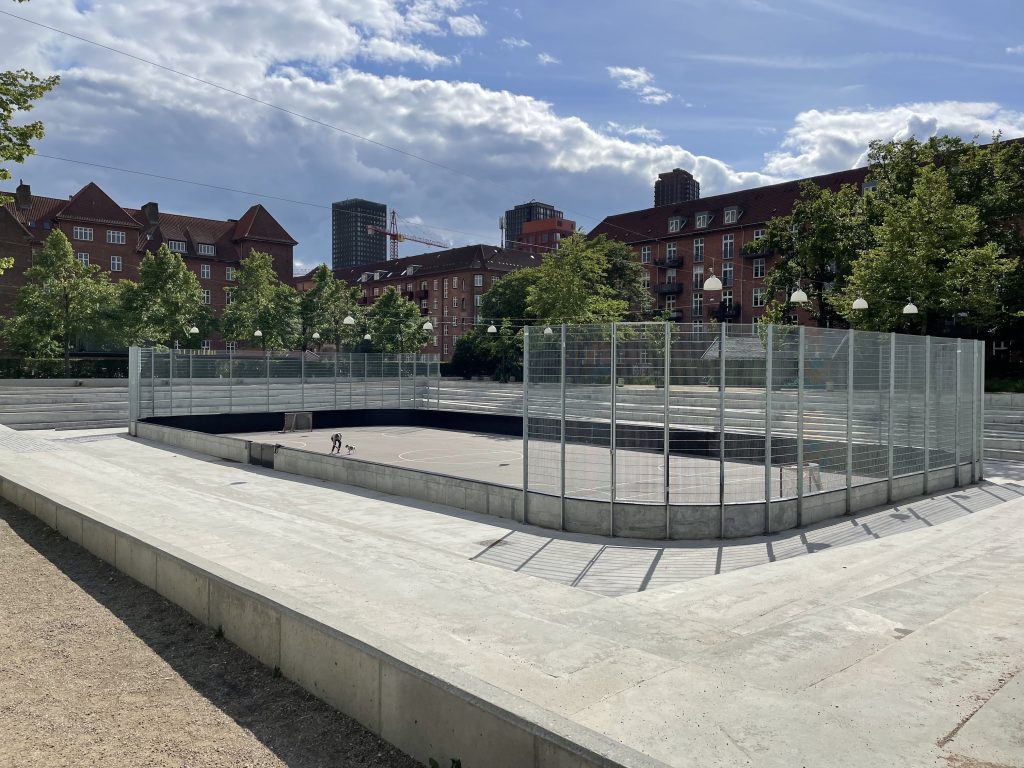The city of Copenhagen is known for being sustainable and happy. One reason for this is the livability of the city’s design.
One aspect of livability in Copenhagen is access to public parks. Locals in Copenhagen use the parks for everything you could imagine. A walk through any park on a sunny day reveals people and children eating, drinking, playing games, sunbathing and napping.
Why It’s Newsworthy: Climate parks are becoming more common in Copenhagen. It is important for travelers to understand where they are coming from and why they are being created.
Enghaveparken
One park that was created with sustainable architecture in Copenhagen is Enghaveparken. Enghaveparken is a place where locals and travelers alike come on sunny days to enjoy Copenhagen.
Anna Thagard, a Copenhagen citizen, says she uses Enghaveparken “quite often in the summertime because it is so full of life.”
Katherine Henson, a Dane sitting in the park with Thagard, says she didn’t like the park at first because it was too much stone and not green enough, but has since come around to enjoying the park.

Both women appreciate the sustainability of the park, especially with the increase in cloudbursts. Thagard mentions the first big cloudburst in 2011, which she calls horrible.
“We have never seen flooding like that before. [It was] 150 millimeters in two hours, and the entire inner city was flooded and it did serious damage,” says Bo Christiansen, CEO and founder of Scaledenmark, about the 2011 cloudburst.
Bo Christiansen is the CEO and founder of Scaledenmark, a Nordic urban leadership program that is “leading leaders through sustainable urban design,” according to their website.
Every person who was in Copenhagen in 2011 has a story about the cloudburst. Enghaveparken was created as a result of that rain storm.
Dani Hill Hansen, an architect and professor in Copenhagen, says “Almost every year, there are cloudbursts, where it rains a lot in Copenhagen really quickly. It’s too much rain to go into the sewer as it was designed earlier because of all the hard surfaces.”
Hansen was always interested in nature and as she grew up and learned about climate change, she felt like it was something that she remained focused on.
Enghaveparken’s Design
Enghaveparken’s unique design uses the park’s location to its advantage. The park is located at the bottom of a hill, an ideal spot for recycling excessive amounts of rainwater. The park’s design uses inclined seating to allow for the capture of rainfall.

The rain is recycled and used for watering plants during dry spells, cleaning Copenhagen’s streets, and flows into a fountain in the park. Enghaveparken is currently the biggest climate project in Copenhagen.
“Enghaveparken project is one of many projects which is a beautiful example of where we can address climate change and issues and problems, but we don’t cry over that. We see that, wow, this is a great opportunity to improve life quality and livability of the citizens,” says Christiansen.
Enghaveparken is a prime example of people seeing a problem and creating a livable solution that benefits the environment and the people in the city. The creators kept in mind the environment, but also the citizens and travelers in Copenhagen.
Christiansen says, “I would say this [Enghaveparken] is a way which is sparking innovation because you’re combining solving a big challenge with recreational qualities that are people-centered.”
Climate Adaptation Parks in Copenhagen
Enghaveparken is one of the many climate projects going on in Copenhagen.
“There’s a few hundred climate adaptation parks over the next 10-15 years that are on-going,” Hansen says. “Enghaveparken is one of the showy and big projects to sort of show people what is going to happen in the rest of the city.“
The amount of sustainable architecture projects are increasing in Copenhagen. This, in turn, increases the livability of the city. Sustainability and livability are two concepts that go hand in hand, building off of each other.
Christiansen is a sustainable architect who incorporates livability into his work. In his words, livability is about creating spaces that benefit users and are good for the planet.
“Places for people, like public spaces, are prioritized here. There’s a lot of parks, there’s a lot of squares. There’s a lot of open space for people. When we prioritize people, usually the solutions are also sustainable,” Hansen said.

The many different parks available in Copenhagen add to the livability of the city. On a sunny day, anyone can find a park within a five- to 10-minute walk in the city.
Having access to public parks increases the livability of the city, which increases people’s happiness and contentedness living in the city. Climate parks, such as Enghaveparken, are practical solutions to problems caused by climate change, showing how sustainability and livability go hand in hand.
Ellie Pool is a junior majoring in journalism in the Grady College of Journalism and Mass Communication at the University of Georgia.








Show Comments (1)